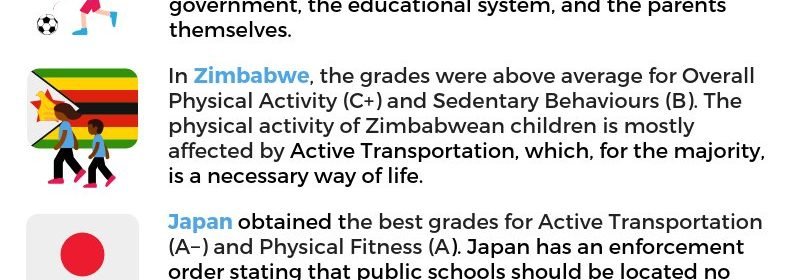Childhood physical inactivity reaches crisis levels around the globe

Children around the world are not moving enough to maintain healthy growth and development, according to a global report released today.
The report by the Active Healthy Kids Global Alliance (AHKGA) compared 49 countries from six continents to assess global trends in childhood physical activity in developed and developing nations, resulting in the “Global Matrix 3.0” comparison of grades.
The report revealed that modern lifestyles—increases in screen time, the growing urbanization of communities and the rise in automation of previously manual tasks—are contributing to a pervasive public health problem that must be recognized as a global priority.
“Global trends, including excessive screen time, are contributing to a generation of inactive children and putting them on a dangerous path,” said Professor Mark Tremblay, President of the AHKGA, Senior Scientist at the CHEO Research Institute in Canada and Professor at the University of Ottawa. “We have a collective responsibility to change this because inactive children are at risk for adverse physical, mental, social and cognitive health problems. This generation will face a range of challenges, including the impacts of climate change, increasing globalization, and the consequences of rapid technological change. They will need to become habitually physically active in order to grow into healthy, resilient adults who can survive and thrive in a changing world.”
The AHKGA international comparison involved 517 experts who produced 49 country report cards, grading 10 common indicators related to the physical activity of children and youth. The resulting report examines global patterns, and highlights how our changing world is affecting children’s physical activity levels. Increases in screen time and a growing reliance on technology are taking up crucial time that could be better spent engaged in a wide range of physical activities; and an increased use of motorized transport is changing physical activity levels globally.
“Pushing back against these lifestyle shifts requires social engineering, not just built engineering, and the challenges vary depending on each country’s stage of development,” said Dr. Tremblay. “It will take many facets of society working together to shift behaviours to preserve and promote our children’s right to play and be active. We hope this report will be a call to action for societies around the world.”
Learning from each other
Countries with the most active children and youth overall, including Slovenia, Zimbabwe and Japan, each rely on very different approaches to get kids moving but what is consistent among all of them is that physical activity is driven by pervasive cultural norms. Being active is not just a choice, but a way of life.
*Slovenia obtained the best grades for Overall Physical Activity (A−), Family and Peers (B+), and Government (A), and received an overall average grade of B.
A notable feature in Slovenia is the importance of sport for the culture of this almost 30-year old country as “Slovenes tend to view sports as an effective tool in fostering national identity among citizens and making successful global identity claims.”
*Zimbabwe reports above-average grades in Overall Physical Activity (C+) and Sedentary Behaviours (B).
Overall physical activity is mostly affected by active transportation which, for the majority of the children in Zimbabwe, is a necessity in everyday life.
*Japan had the best grades for Active Transportation (A−) and Physical Fitness (A), and had no grades lower than C−.
Japan has a highly established “walking to school practice” that has been implemented since the School Education Act enforcement order, enacted in 1953. It states that public elementary schools should be located within no more than 4 km, and for public junior high schools no more than 6 km from the student’s home.
Source: Read Full Article
